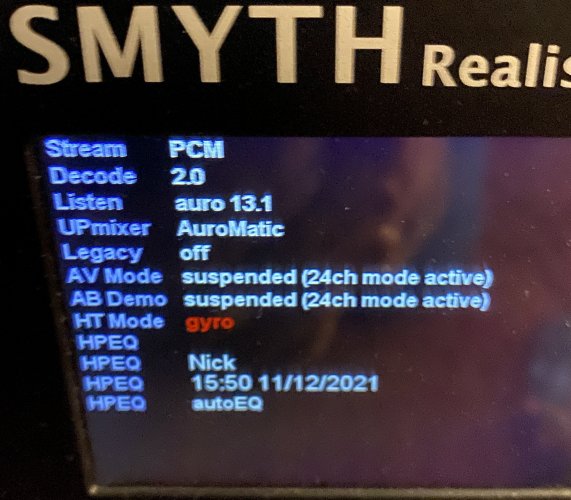@mrmac:
Some advice that may be helpful from someone who has only been doing PRIRs at home recently, with the good fortune of following the advice of the many pros here.
If your hardware only runs 2.15 firmware, wait until new firmware that, we hope, fixes the PRIR and HPEQ issues is released.
Positioning the microphones is tricky, particularly by yourself (which is what I do). I found Rene's post #7381, with the photos, very useful. I use the positioning and cord routing that is shown there.
I use the "headtracker assist" mode, rather than marking positions in the room. You'll need a small speaker that you can plug into the L/R HP-A RCA outputs. During the async measurement of each speaker (not the calibration round, the actual measurement round) there will be a pair of high-pitched beeps just before the sound that instructs the A16 to measure the particular speaker. Be prepared to hit "pause" the moment you hear them! Your external speaker will give you feedback on head position. Simply turn and tip your head until the sound goes away. Fix your eyes on some object on the wall in that position and hit "play" to continue.
As the old joke goes ("Q: How do you get to Carnegie Hall?", "A: Practice!!!") practice at home with the async files. At the very least watch the 9.1.6 Atmos Async file to be prepared for the sequence of steps. You can always use a 5.1 file at home to have a shorter practice session, but it will be very useful because the first few times the steps come very fast. Best to have repeated it enough so that it is boring. The practice will also help you "pause" and "play" on the remote without looking.
The Club Realiser async files do not have a "noise" section at the beginning to set overall system volume. You can get a useable noise file from the async files in the Google Drive, Room 25. The sound level is surprisingly high, though not noticeable with your microphones in place. On my system a normal listening level is -20dB, and the A16 measured recommended level is something like -4dB. The noise file is a 12-channel WAV file, so you'll need something to play it (a windows PC with VLC works fine, and either the AVR or media player at the studio will probably be able to handle it).
Make sure the actual speakers fire according to the movie from the async file. I used a 5.1.2 async file at home initially, and had my AVR setup incorrectly and discovered afterwards that both Lss and Lb measurements used my Lss, likewise for Rss and Rb. I needed to use "Direct" mode on my Denon. Also pay attention that the mode utilizes the room equalization setup in the AVR; on my Denon that means "Direct" and not "Pure Direct". For 9.1.6 I would guess any mismatch to the Club Realiser file would be very unlikely, but best to check. You can use "preamble override" as necessary to correct a mismatch (for example, Lb swapped with Lss). The order of the speaker names, and the names themselves, in your PRIR sound room will be used in the resulting PRIR file in the order that the async file does the measurement.
Save some time and pre-populate your PRIR sound room file with virtual speaker names matching the names shown in the Club Realiser async video.
My room at home and AVR is 7.1.2, so I did two PRIR measurements, one facing forwards and one facing backwards (with preamble overide), with the virtual speaker names in the PRIR sound room appropriately swapped left for right for facing backwards. This lets me build listening rooms with larger speaker counts, and with the speakers sounding at the correct positions. At your studio, this will let you measure a center rear, and depending on seating position, you might find later that you prefer building a listening room with some of the backwards measurements.
Be sure to build a listening room or two or three from your PRIR files after your measurements and check that you are happy with the results. Best to bring your favorite MCH samples. And, using "test"mode on the A16, it's useful to listen to each virtual speaker one at a time to be sure you are happy with the apparent placement. The actual async measurement doesn't take that much time, so take advantage of the studio time to perfect your PRIRs.
During the async measurements your A16 need only be connected to your microphones and head tracker (and small external speaker if you use headtracker assist mode), so place the A16 in a convenient spot next to you in the studio room. That little LCD screen is very difficult to see otherwise.
After you join Club Realiser, be sure to download their A16 manual. I used Acrobat Reader if I recall correctly to translate the French into English. Sometimes just seeing a particular A16 operation described by a different person makes all of the difference in coming to the correct understanding.
 ), but...
), but... ), but...
), but...


















